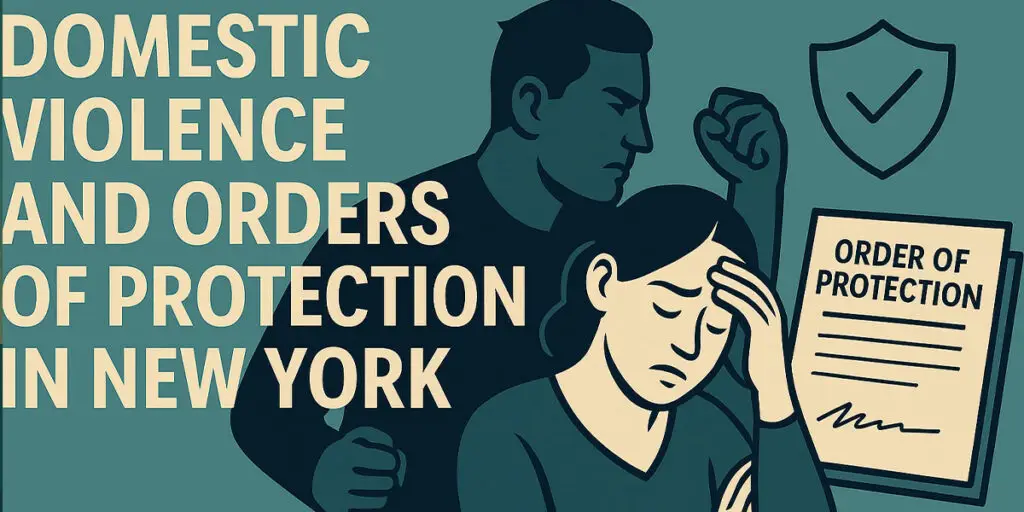Understanding Domestic Violence and Orders of Protection in New York: Protecting Yourself and Your Family
Domestic violence is a serious issue that affects individuals and families across New York State. If you are experiencing domestic violence, it’s important to know that you are not alone and that there are legal resources available to protect you and your children. Obtaining an order of protection, also known as a restraining order, is a crucial step in ensuring your safety and preventing further abuse. Knowing that you are protected is one of the many benefits of having a protective order. At Morgan Legal Group, serving New York City and beyond, we provide compassionate and effective legal representation to victims of domestic violence, helping them obtain orders of protection and navigate the complex legal system. This comprehensive guide explores the key aspects of domestic violence and orders of protection in New York, providing valuable insights into your rights, how to obtain an order of protection, and how to protect yourself and your family. The protection of yourself and your family is of utmost importance.
What is Domestic Violence? Understanding Abuse in New York
Domestic violence is defined as a pattern of abusive behavior in any relationship that one partner uses to gain or maintain power and control over another intimate partner. It encompasses a wide range of abusive behaviors, including:
- Physical abuse (e.g., hitting, slapping, kicking, shoving)
- Emotional abuse (e.g., verbal abuse, intimidation, threats, isolation)
- Sexual abuse (e.g., forced sexual activity, unwanted touching)
- Financial abuse (e.g., controlling finances, preventing you from working)
- Stalking (e.g., repeated unwanted contact, surveillance)
- Harassment (e.g., unwanted phone calls, texts, emails)
Domestic violence can occur in any type of relationship, regardless of gender, sexual orientation, or socioeconomic status. It is a serious matter that must be handled as soon as possible. It is best to understand the different types of abuse.
Who Can Obtain an Order of Protection in New York?
In New York, you can obtain an order of protection if you have a qualifying relationship with the abuser, such as:
- Spouse or former spouse
- Parent of a child in common
- Person with whom you have an intimate relationship
- Family member (related by blood or marriage)
If you do not have one of these relationships with the abuser, you may still be able to obtain a restraining order through a civil lawsuit. Obtaining information from an attorney will help decide your next steps. There are processes and steps that need to be followed to ensure a successful case.
Types of Orders of Protection Available in New York
There are two main types of orders of protection available in New York:
- Temporary Order of Protection: This order is issued ex parte, meaning the abuser does not need to be present in court when it is issued. A temporary order of protection is typically issued at the beginning of a case and remains in effect until the next court date.
- Final Order of Protection: This order is issued after a hearing where both parties have the opportunity to present evidence and testimony. A final order of protection can last for up to two years (or five years in certain cases) and can include more extensive restrictions on the abuser’s behavior.
Both types of orders of protection provide legal protection from abuse, but a final order of protection offers more long-term security. Both orders help serve as a means of protection. They have the power to help prevent further harm.
What Does an Order of Protection Do? Restrictions and Protections
An order of protection can impose various restrictions on the abuser’s behavior, such as:
- Staying away from you, your home, your workplace, and your children’s school or daycare
- Refraining from contacting you in any way (e.g., phone, text, email, social media)
- Surrendering any firearms they possess
- Refraining from committing any further acts of violence or harassment
An order of protection can also grant you certain rights, such as temporary custody of your children and exclusive use of your home. Your legal rights will always be upheld. It is all designed to protect you.
Obtaining a Temporary Order of Protection: The Process
To obtain a temporary order of protection in New York, you must file a petition with the Family Court or the Integrated Domestic Violence Court in your county. The process is usually very efficient. You will then file and prepare certain documentation.
The petition should:
- Describe the abuse you have experienced
- Explain why you need an order of protection
- Request the specific restrictions you want the court to impose
You will typically need to appear in court to explain the situation to a judge or magistrate.
If the judge believes there is a credible threat of harm, they will issue a temporary order of protection. This process is designed to act quickly. You should act fast and get the proper order in place to protect yourself.
The Hearing for a Final Order of Protection: Presenting Your Case
To obtain a final order of protection, you will need to attend a hearing where both you and the abuser have the opportunity to present evidence and testimony. You will need to prepare to speak about what has happened. You should obtain all the evidence to prove your case.
Evidence you can present:
- Photos of injuries
- Medical records
- Police reports
- Witness testimony
- Text messages or emails
You have the right to an attorney to represent you at the hearing. It can be very helpful to have a representative. They will know what the best steps are to take.
What Happens If the Abuser Violates the Order of Protection?
Violating an order of protection is a crime in New York. If the abuser violates the order of protection, you should immediately contact the police and report the violation. Report if there has been contact. It is important to get the situation on the books if it does occur. The police may arrest the abuser and charge them with a crime.
You can also file a petition with the Family Court to have the abuser held in contempt of court. Contempt of court can result in fines, jail time, or other penalties. It is a strong step to take.
Orders of Protection and Child Custody: Protecting Your Children
Domestic violence can have a significant impact on child custody arrangements. When making custody decisions, New York courts prioritize the best interests of the child. A history of domestic violence by one parent can be a significant factor in determining custody and visitation. The best interest of the children is of the upmost importance, and will always be considered.
If there has been domestic violence in your family, it’s important to:
- Inform the court about the abuse
- Provide evidence of the abuse
- Request supervised visitation or other safety measures to protect your children
Protecting your children from harm is paramount. Do not leave your children in an unsafe situation. It is important to consult with a lawyer regarding this matter.
Documenting Abuse: Keeping a Record of Incidents and Evidence
Thorough documentation is essential for building a strong case for an order of protection and for protecting your rights in any related legal proceedings. Here are some different elements to consider.
Documentation could include:
- Photos of injuries
- Medical records
- Police reports
- Text messages or emails
- Witness statements
- A journal or diary of abusive incidents
Keep all documentation in a safe and secure location. The evidence is important for your case. You never know when it might be needed.
Seeking Support and Resources: You Are Not Alone
If you are experiencing domestic violence, it’s important to remember that you are not alone and that there are resources available to help. In these situations there are numerous resources that you can and should utilize.
Consider:
- Domestic violence shelters
- Counseling and support groups
- Legal aid organizations
- Hotlines and crisis intervention services
Reaching out for help is a sign of strength, not weakness. You are in charge of what you allow into your life. Do not hesitate to get support.
Working with a Compassionate and Experienced Attorney
Navigating the legal system while dealing with domestic violence can be overwhelming. It’s important to work with an attorney who is not only knowledgeable about the law but also compassionate and understanding. It is important to have all legal aspects in order. They can support you in the best way possible. You should seek out someone trustworthy.
Look for an attorney who:
- Has experience handling domestic violence cases
- Is committed to protecting your safety and well-being
- Communicates clearly and effectively
- Is responsive to your needs
Compassionate and effective legal representation can make a significant difference. Seek support with a lawyer who knows the area well.
Protecting Your Future with Morgan Legal Group
At Morgan Legal Group, we are dedicated to providing compassionate and effective legal representation to victims of domestic violence throughout New York City and beyond. Our experienced attorneys can help you obtain orders of protection, navigate the legal system, and protect yourself and your family. Reach out to us today to schedule a consultation and learn more about how we can help you. You can also view our GMB by clicking here. Your safety matters. We can provide the protection you need.
Morgan Legal Group proudly serves the New York City community including the Bronx, Brooklyn, NYC, Queens, and Staten Island. If you are outside of New York City we also serve Long Island including Suffolk County. As well as Westchester, Ulster County, and Orange County.NY Courts







